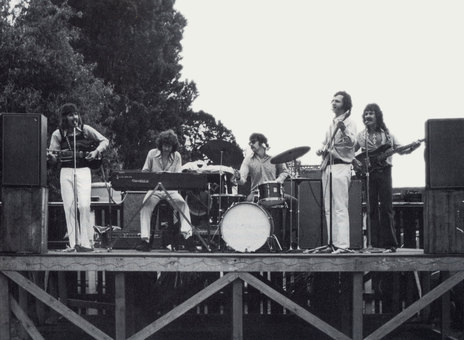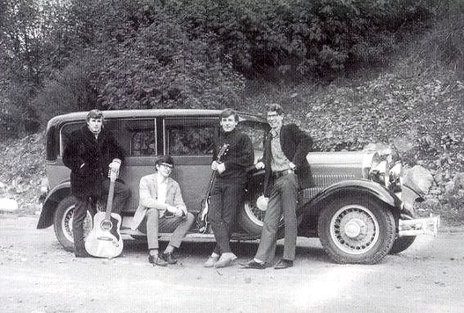AudioCulture
The noisy library of New Zealand music
Te pātaka korihi o ngā puoro o Aotearoa
The Music Convention
aka The Trends, The Spectres
In 1966, the Trends moved to Auckland and changed their name to The Music Convention. There they recorded the soundtrack to New Zealand’s classic surf movie, Children Of The Sun, and the psychedelic oddity ‘Footprints On My Mind’. It didn’t matter that the band originated in landlocked Hamilton and had never dabbled in anything stronger than the occasional drink.
To the outsider, Hamilton in the 1960s seemed a cold, conservative place, a gangly teenager of a city that had barely emerged from its provincial past. And infertile ground for the hardy seed of rock and roll.
But sprout there it did. Ivor Fisher and The Satellites and The Mods recorded a handful of singles, and musicians such as Chris Thompson (of The Paragons) and Garth Porter went on to find fame overseas — Thompson with Manfred Mann’s Earth Band and Night, and Porter with Sherbet.
The Spectres grew out of the trio’s early fascination with folk music.
Based around the nucleus of brothers Robert and Greg O’Donnell, and drummer Sean Kelly, The Spectres grew out of the trio’s early fascination with folk music.
Greg O’Donnell: “My brother and I started playing guitar with serious intent around the age of 12. Influences at that point were mostly folk groups – the Kingston Trio springs to mind.
“With a school friend, Sean Kelly, on bongos (someone had to be the drummer), a group was born. We called ourselves The Spectres and played around at parties. A major event for us at that time was the Johnny Cooper Talent Contest, which we made the finals of, after many tedious appearances on semi-finals/quarter finals.”
The Spectres were also picking up gigs around town, churning out Cliff and The Shadows’ ‘Apache’ up to six times a night at venues like their regular monthly spot at Tauwhare War Memorial Hall, a few kilometres out of Hamilton.
Then The Beatles struck Hamilton. In their wake emerged The Stoners, The Mods, The Paragons and The Spectres – this time re-christened as The Trends. The acts were all playing young sounds. They were young upstarts challenging the Saturday night status quo of The Starlight Ballroom and long standing rock and roll champions, The Satellites Showband.
Greg O’Donnell: “We changed our name to The Trends and became regular performers at a new club called The Three Musicians in the (now demolished) Embassy Theatre in Victoria Street.” Run by enthusiast Mike Henri, the club gave young bands a chance to cut their teeth in a more serious fashion. The club also featured touring bands such as The Rayders and The Pleazers.
But it wasn’t enough for the notorious Stoners, a hard bunch of rebellious farm boys from the Waikato, who had an affection for The Beatles, and later, The Pretty Things. They wanted in on the Tauwhare Hall gig.
Kitted out with the latest mod gear and boasting the loudest equipment around, they showed up one evening and promptly demanded to play, succeeding in persuading the hall committee to let them share the gig with The Trends.
The Trends were stretching out into the Waikato province hinterlands, playing at surrounding towns such as Morrinsville, Te Awamutu and Thames to supplement their city shows. One memorable occasion took them to coastal city Tauranga to play at the Embers, the teen nightclub run by original Four Fours drummer, Trevor Spitz.
Robert O’Donnell: “Trevor Spitz took us to one side before the show to tell us there were a few rockers around. We’d only been playing a few moments when Ken Murphy (Trends guitarist), who’d had a lot of mates come over with him, suddenly dropped his guitar on stage and shot out the door. He came back with his shirt ripped and nose bloody. He’d been out helping his mates fight these rockers in the street.”
As The Trends emerged to pack their gear into the trailer, they were surrounded by rockers, who insisted the band play at their early morning party.
Warned of the continued presence of troublemakers outside the venue, they lingered later than usual, into the early hours to avoid further trouble. But as The Trends emerged to pack their gear into the trailer, they were surrounded by rockers, who insisted the band play at their early morning party. To make sure the band complied, they sandwiched The Trends' vehicle between two cars on the drive down Tauranga’s long main street (the Cameron Drive double lane motorway) with a third car hovering in the second lane beside The Trends.
Which worked fine until The Trends spotted a late night petrol station. They promptly veered into it and Robert O’Donnell raced for the phone, only to be confronted by the pump attendant, a friend of the rockers. Back on the road, the band searched for another escape route, finally ducking off down a dark side street and hiding until their kidnappers tired of the hunt.
Back in Hamilton, they continued to play around town with a set, which now included The Byrds, folk rock and more adventurous new American sounds.
In early 1966, Greg moved to Auckland to begin a graphic arts course. Robert followed a few months later and The Trends re-formed, scoring work at the Platterack and Top 20 clubs and a variety of school dances and functions, including an annual P&O cruise.
In 1967, following Robert’s National Service stint, The Trends re-formed as The Music Convention, minus Ken Murphy, who went on to form The Real Thing, a vocal duo with former Sounds Unlimited vocalist (and HMV/EMI producer) Alan Galbraith. Murphy was replaced by keyboard player Graeme Webber, who the band met at Piha Beach, a popular surfing and holiday spot west of Auckland. The Trends played regularly there during summer at the surf club.
Out in the audience was a young surfer and would-be surf filmmaker.
Greg O’Donnell: “Graeme hadn’t played in any bands before joining us – a true closet pianist. But he was soon coerced into the band’s ranks.”
Webber wasn’t the only connection the band made at Piha. Out in the audience was a young surfer and would-be surf filmmaker, Andy McAlpine. More about him later.
Back in the city, the band scored a deal with RCA Records and were preparing to release their first single, ‘Have You Seen My Limousine?’b/w ‘Good Clean Fun’. Both songs were originals, recorded at Astor Studios with producer Wahanui Wynyard. It was released under the temporary Bob, Graeme, Sean and Greg moniker.
Robert O’Donnell: “We were the first band to be released on the RCA label in New Zealand. We managed to get some pretty good airplay on the hot stations of the time like Hauraki (NZ’s pirate radio station). They didn’t know we were a New Zealand band as there was nothing to suggest that on the record.”
And play it they did, at least until the band decided to do a bit of gimmicky advertising, parading around town with signs on their cars asking, “Have You Seen My Limousine?” and answering “It’ll Be Here Soon” or “It’s On The Radio”. They also filmed a Benny Hill-like video in a Gillies Ave quarry to go with the song.
Robert O’Donnell: “It was at that stage we decided to go to Hauraki to get an interview on air. I spoke to [Hauraki DJ] Peter Telling. Once it was out that we were a New Zealand band, we just tumbled right off the song list.”
“Before that they’d been saying on-air, ‘Here’s the latest band out of California.’ ”
Andy McAlpine had just asked them to record the soundtrack to his pioneering surf movie, Children Of The Sun.
The New Zealand knocking machine pissed the band off no end. By then, however, they had other things on their minds. Andy McAlpine had just asked them to record the soundtrack to his pioneering surf movie, Children Of The Sun, filmed around some of New Zealand and Australia’s best surf spots with a cast of New Zealand waxies.
By now, Greg had left the graphic arts course and was working for the Auckland Star, the city’s afternoon daily paper. Among his workmates was a recently arrived Indian cartoonist called Darryl Kirby, who owned a sitar.
With the Beatles and other British rockers delving into Indian music, O’Donnell decided to do likewise and borrowed the instrument.
Out of that strange sequence of events grew a startling series of sitar-driven surf instrumental tracks, including the crunching, fuzz-scorched ‘Belly Board Beat’ and the wiggy surf epic, ‘Theme from Children of the Sun’, all recorded after sitting down and watching the film’s silent rough cut. The band then decided the film had fourteen moods in all and proceeded to arduously piece together the songs in the studio with Wahanui Wynyard, where not a beat could be out of place without throwing out the timing with the visual sequences.
The movie went on to garner good local reviews and was shown in New Zealand and Australia, gaining some encouraging words from American surf movie guru Bruce Brown along the way.
Greg O’Donnell remembers, “I don’t think we regarded ourselves as a true surf music group although our presence at Piha and our involvement in the film did influence us to a degree. Certainly in our repertoire there were Beach Boys covers and the odd Ventures surf instrumental.”
‘Footprints On My Mind’ used the same sitar sound as their surf record, but introduced hilarious druggy lyrics.
The Music Convention’s previous single had been just as strange – from the surf instrumental band that didn’t surf came a psychedelic pop single from a band that didn’t take drugs. ‘Footprints On My Mind’ used the same sitar sound as their surf record, but introduced hilarious druggy lyrics, containing many acid images and references.
The Music Convention hadn’t finished with movies yet either. They were asked to record a song based on the 1968 film The Charge of the Light Brigade, to play in theatres around New Zealand. The resulting song, ‘Ballad of the Light Brigade’ was sound effect overkill city with the band’s original song competing with cannon fire, trumpets and other battle sounds. Much more interesting was the flipside, a version of Chuck Berry’s ‘Berry Rides Again’, which along with their previous single, a version of Harry Nilsson’s ‘One’, had arrived at RCA as a demo from America. (RCA wanted The Smoke to record it but they declined.)
‘One’ gained good airplay on release, but quickly dropped from the charts when the Bee Gees recorded a version shortly afterward.
And that’s where we leave The Music Convention. There would be more bands of course, right up to the present day, and the recruitment of The Bluestars’ Rick van Bokhoven along the way, but the remarkable Children Of The Sun EP and ‘Footprints On My Mind' are the band’s lasting legacy.


Ken Murphy - guitar
Robert O’Donnell - bass, vocals
Greg O’Donnell - guitar, vocals
Sean Kelly - drums
Graeme Webber - keyboards
RCA
Visit our sister site
NZ On ScreenMade with funding from
NZ On Air
